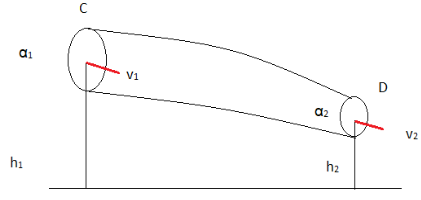Answer:
A Swiss mathematician Daniel Bernoulli (1738) discovered this theorem that describes the total mechanical energy of the moving fluid, consisting of the energy associated with the fluid pressure and gravitational potential energy of elevation and the kinetic energy of the fluid remains constant.
Bernoulli’s theorem states the principle of conservation of energy for standard fluids. This theorem is the basis for many engineering applications.
Proof
Let’s consider a tube of flow CD as shown in figure A. Let, at point C, α1 be the cross-sectional area, v1 be the velocity of the liquid and P1 be the pressure. On the other hand, let α2 be the pressure, v2 be the velocity and P2 be the pressure at the point D. Let, h1 and h2 be the heights of the tube by which the tube is raised.
Figure A
The force exerted by the liquid at C is P1α1.
The work done by the mass entering the tube through the cross-sectional area α1 at the point C per unit time is P1V.
Where,
V= α1v1 is the volume of the liquid entering C.
The work done is stored in liquid and is called pressure energy.
So, the pressure energy per unit volume at the end C is P1.
If m is the mass of the liquid entering at the point C per unit time, then the pressure energy of the liquid at C= m (P1/ρ).
where pressure energy per unit mass is P1/ρ
and ρ is the density of the liquid.
The kinetic energy of the liquid at the point C is ½ mv12
The potential energy of the liquid at the point C is mgh1
So, the total energy at the point C is given by,
mP1/ρ + ½ mv12 + mgh1 (1)
Similarly, the total energy at the point D is given by,
mP2/ρ + ½ mv22 + mgh2 (2)
From the principle of conservation of energy,
m P1/ρ + ½ mv12 + mgh1 = mP2/ρ + ½ mv22 + mgh2
or, P1/ρ + 1/2 v12 + gh1 = P2/ρ + 1/2 v22 + gh2
or, P/ρ + ½ v2+ gh = constant
This is Bernoulli’s theorem.
P/ρg+ v2/2g+ h = constant
P/ρg is called the pressure head
v2/2g is called the velocity head
h is called elevation head.
 Profile
Profile Settings
Settings Refer your friends
Refer your friends Sign out
Sign out







